The year 2020 marks the centenary of London’s Imperial War Museum, a site exploring the history of conflict from the First World War through the present day. Located south of the River Thames at Lambeth, the museum’s compelling exhibits help us appreciate what life was like during wartime, both for the military and for civilians.
Among the many items on show are the atomic bomb Little Boy at the start of the Cold War section – don’t worry, it’s defused; the Enigma Machine the Germans used to encode their messages during WW2; and the headgear worn by Lawrence of Arabia, or ‘Amir Dynamite’, as his Arab friends called him.
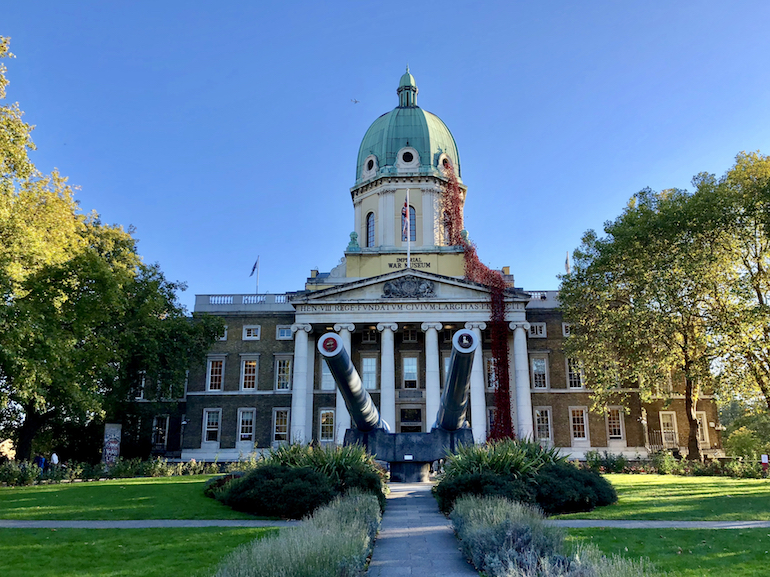 Entrance to Imperial War Museum London. Photo Credit: © Ursula Petula Barzey.
Entrance to Imperial War Museum London. Photo Credit: © Ursula Petula Barzey.
But even the building itself has a fascinating history. A hundred years ago, it was Bedlam, London’s principal mental hospital. This is recalled in the Latin inscription above the grand columned portico: HEN VIII REGE FUNDATUM CIVIUM LARGITAS PERFECIT, which means ‘Created by King Henry VIII from the generosity of the city’. Bedlam had existed since 1247 as part of the monastery in London of St Mary Bethlehem. When Henry VIII dissolved the monasteries in the 1530s, he re-established the hospitals and schools, which they had run, as secular institutions in his own name. The wealth came from the sale of the church land on which the monastery had stood.
In the 18th century, the hospital, then based farther north at Moorgate, became dilapidated. The present building was then built to designs by the architect James Lewis and completed in 1815. One of the patients during the 19th century was the architect Augustus Pugin, co-designer of the Houses of Parliament, who had suffered a mental breakdown. From his cell he could see, next to the hospital, another of his buildings, the Roman Catholic cathedral of St George’s Southwark where he had got married. In the 1890s, the music hall artiste Hannah Chaplin, mother of Charlie, was briefly at Bedlam. As London expanded, hospitals including Bedlam moved into the suburbs.
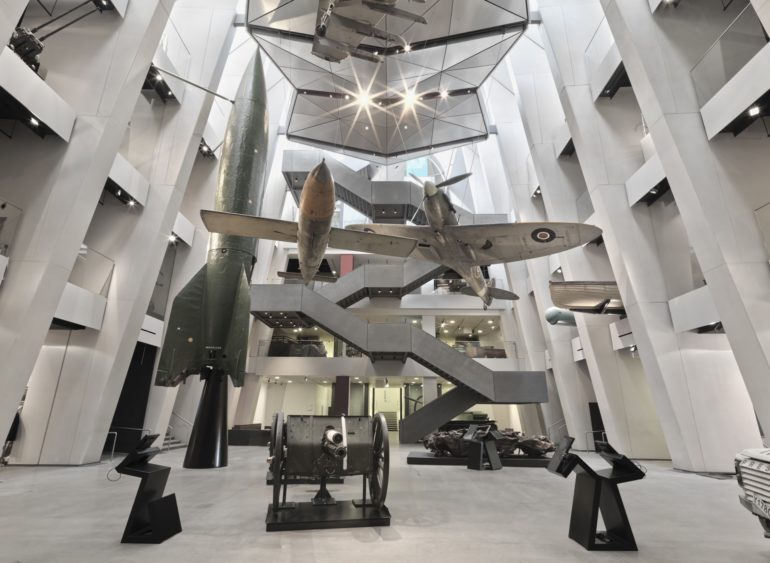 General view of the Atrium at Imperial War Museum London. Photo Credit: © Imperial War Museum.
General view of the Atrium at Imperial War Museum London. Photo Credit: © Imperial War Museum.
The museum was established in 1920 to give testament to the devastation of the First World War, then known as the Imperial War because it was the first conflict in history between rival empires, in this case Britain, Germany, and Russia. As the dominions stretched around the world, so did the war.
At the start, the exhibits were mainly paintings by the war artists. The Imperial War Museum had two other homes before moving into the vacant hospital premises in 1930. The press baron Lord Rothermere, owner of the Daily Mail and Daily Mirror, bought the land and gave it to the museum. He stipulated that the park around it should be known as the Geraldine Mary Harmsworth Park after his mother. Even without visiting the museum, it is a lovely place to eat your sandwiches or follow the trail of the 35 native trees of Great Britain.
 Reuters Armoured Land Rover at Imperial War Museum London. Photo Credit: © Ursula Petula Barzey.
Reuters Armoured Land Rover at Imperial War Museum London. Photo Credit: © Ursula Petula Barzey.
When the Second World War broke out, the new Imperial War Museum was high on the list of targets for the German Air Force, the Luftwaffe, and plans were made to transfer the artworks to safe locations. There were too many to relocate at once, so the paintings were categorised by value and prioritized. This development was the subject of the museum’s most recent temporary exhibition, Culture Under Attack.
In 1945, the Museum decided to include exhibits from the most recent war as well as other conflicts during the 20th century. The 1982 Falklands War, for instance is represented by, among other items, the latex rubber puppet of Prime Minister Margaret Thatcher from the BBC satire Spitting Image. The Iraq wars are recalled most tellingly by the press Land Rover riddled with bullet holes as it was the first conflict to have an immediate television coverage. The entire third floor of the Museum is a Holocaust memorial.
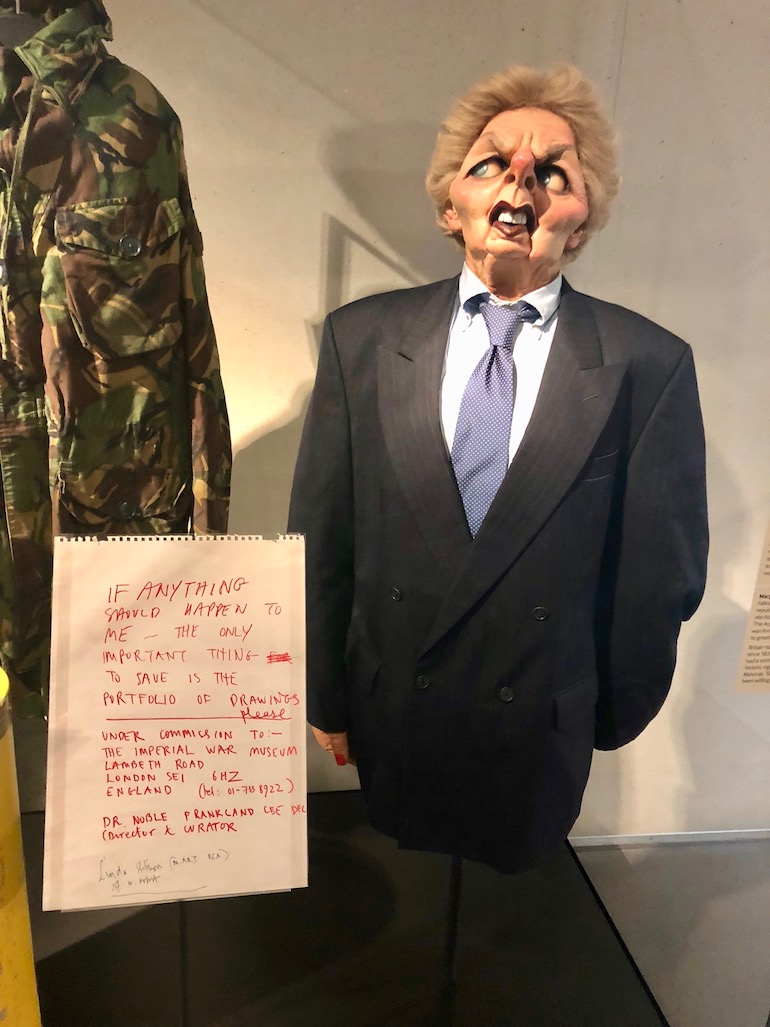 Puppet of Prime Minister Margaret Thatcher at Imperial War Museum London. Photo Credit: © Ursula Petula Barzey.
Puppet of Prime Minister Margaret Thatcher at Imperial War Museum London. Photo Credit: © Ursula Petula Barzey.
But while some of the original artworks have returned (e.g., Paul Nash’s The Mule Track, William Orpen’s Signing of the Versailles Treaty and Stanley Spencer’s Welders 1941), most have remained in storage. In their place are videos like the excerpts from the chilling Nazi propaganda film of the Nuremberg Rally by the filmmaker Leni Riefenstahl, harrowing footage of the burning of Hamburg after the Allied carpet-bombing campaign or clips of cheerful Brits in the blitz singing defiant pub songs around the piano. Visitors who come on an Imperial War Museum Tour led by the writer of this blog end at the nearby Three Stags pub, where Charlie Chaplin’s alcoholic father drank, and where a rendition of the old-time war songs takes place with the tour guide at the piano.



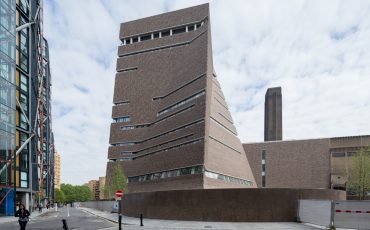
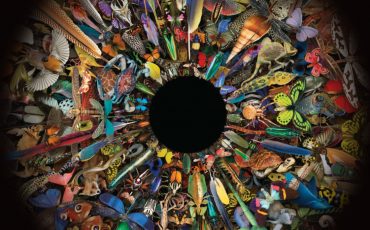


Leave a Reply